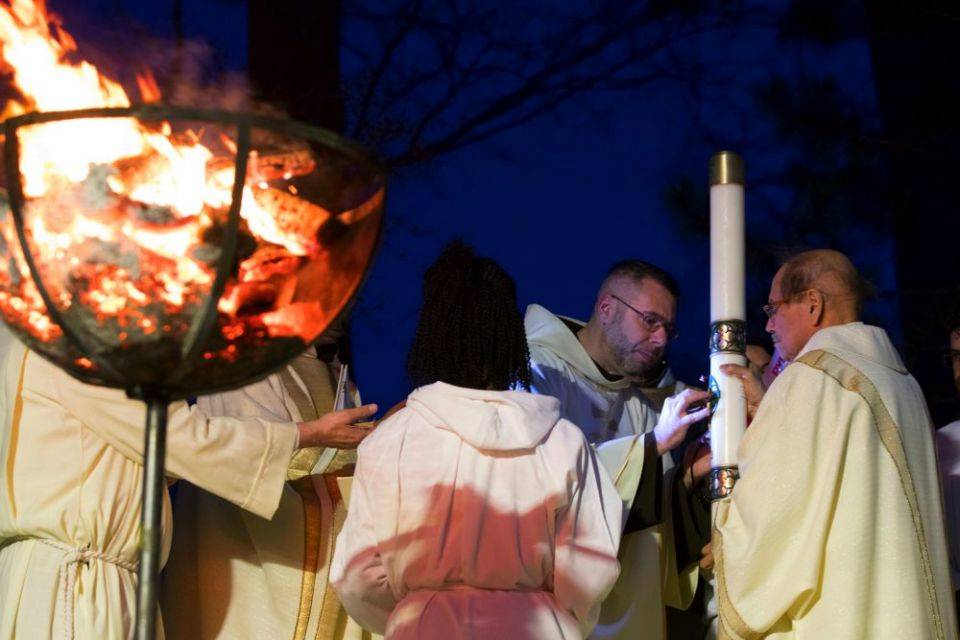Pictured left: Franciscan Fr. Erik Lopez from St. Camillus Catholic Church in Silver Spring, Maryland, marks the paschal candle at the beginning of the 2018 Easter Vigil March 31. (CNS/Octavio Duran)
The symbols we employ during the sacred triduum have reminded us of their power in recent days.
The water of baptism is the foremost symbol of the paschal mystery. Water cleans the body and, in baptism, the unseen soul, taking away original sin and infusing the baptized with grace. Water is also a sign for formlessness before God created the world and from which he brought forth life. Water is also, as our friends who live and farm on the banks of the flooding waters of the Mississippi have learned, enormously destructive.
The great Easter Vigil starts with the lighting of the sacred fire, which pierces the darkness of the night and of sin, illuminating our hearts with divine love as it fills our churches with light that flickers off the mosaics and shines through the stained glass. Monday night, we were reminded that fire can destroy, as flames spread across the roof of Notre Dame Cathedral, filling our souls with sadness instead of light.
I admit to a certain bias, but I think words are always powerful. The words of the Easter triduum — “Take and eat, for this is my body,” “My God, my God, why have you abandoned me?” “Why do you seek the living among the dead? He is not here. He has been raised” — are as familiar as any words in Scripture, yet they still pack a punch. In the climactic scene of the novel Brideshead Revisited, the dying Lord Marchmain, so long the scoffer, so long unwilling to admit that his pleasure was a sin, is unconscious and his daughter brings in a priest, Fr. Mackay, who gives the last rites and says the words of absolution. The narrator of the tale, Charles Ryder, who had not wanted to call for a priest at all, who had framed that decision as a choice between science and superstition, nonetheless prayed for a sign:
“God, if there is a God, forgive him his sins, if there is such a thing as sin.” I suddenly felt the longing for a sign, if only of courtesy, if only for the sake of the woman I loved who knelt, I knew, praying for a sign. It seemed such a small thing that was asked — the bare acknowledgement of a present. A nod in a crowd. I prayed more simply: “God forgive him his sins and please, God, make him accept your forgiveness.” So small a thing to ask. [Charles and the others watch as Lord Marchmain makes the sign of the cross and then lapses back into unconsciousness ] Then I knew the sign I had asked for was not a little thing, not a passing nod of recognition. And a phrase came back to me from my childhood, of the veil of the temple being rent from top to bottom.
The rending of the veil of the Temple, like the crucifixion it completed, happened once and for all, yet in the three days that begin tonight, we believe that we can yet participate anew in this great mystery, not as a bystander asking for a sign, but as a disciple who has already acknowledged that to which the sign refers.
The words of absolution Fr. Mackay prayed over the dying Marchmain would have been in Latin, of course, but our contemporary English words of absolution are as powerful as any ever written: “God the Father of mercies, through the death and resurrection of his Son has reconciled the world to himself and sent the Holy Spirit among us for the forgiveness of sins. May God give you pardon and peace and I absolve you from your sins in the name of the Father, and of the Son, and of the Holy Spirit. Amen.” Those words are as powerful as the flames that brought down the roof of Notre Dame, as powerful as the waters of the Mississippi, as powerful as anything we can conceive.
By Michael Sean Winters
Published on the National Catholic Reporter website.


